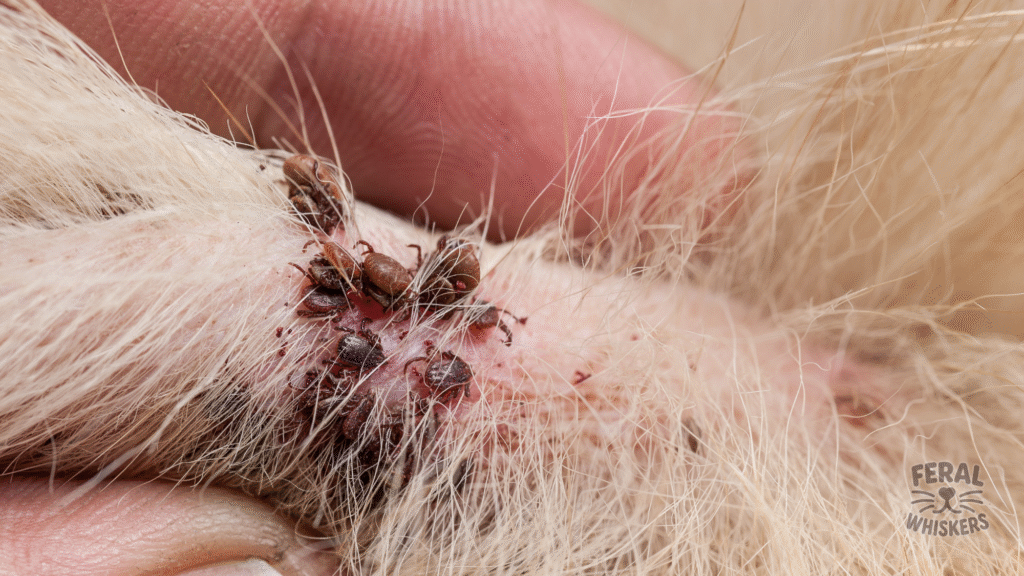Why Tick-Borne Diseases Matter

Ticks are more than just annoying pests. When they feed, they can pass dangerous bacteria, parasites, or viruses directly into your dog’s bloodstream. Some diseases stay hidden for weeks or months before showing signs.
Left untreated, tick-borne illnesses can cause chronic pain, organ damage, or even be fatal. That’s why recognition, testing, and prevention are so important.
1. Common Tick-Borne Diseases in Dogs
Lyme Disease (Borrelia burgdorferi)
- Spread by black-legged ticks (deer ticks).
- Takes roughly 24 to 48 hours of feeding to transmit.
Ehrlichiosis (Ehrlichia canis)
- Carried by the brown dog tick.
- Very common in warmer climates.
Anaplasmosis (Anaplasma phagocytophilum, Anaplasma platys)
- Spread by the same ticks as Lyme disease or brown dog ticks.
Rocky Mountain Spotted Fever (Rickettsia rickettsii)
- Spread by American dog ticks and lone star ticks.
- Occurs in the Americas, despite its name not just in the Rockies.
Babesiosis (Babesia canis, Babesia gibsoni)
- A parasite (protozoa) that infects red blood cells.
- Can also spread through dog fights or blood transfusions.
2. Symptoms of Tick-Borne Diseases
Symptoms vary, but many overlap. Some show up days after a tick bite; others take months.
General Signs:
- Fever
- Lethargy, weakness
- Decreased appetite
- Enlarged lymph nodes
Lyme Disease:
- Limping that comes and goes (shifting-leg lameness)
- Painful, stiff joints
- Swollen joints (arthritis-like symptoms)
- In severe cases: kidney damage → increased thirst, urination, vomiting
Ehrlichiosis:
- Fever, weight loss
- Bleeding issues (nosebleeds, bruises)
- Pale gums, anemia
- Neurological signs in chronic cases
Anaplasmosis:
- Fever
- Joint pain / stiffness
- Vomiting, diarrhea possible
- Platelet issues → bleeding tendencies
Rocky Mountain Spotted Fever:
- High fever
- Swollen lymph nodes
- Muscle or joint pain
- Skin bruising, spontaneous bleeding
- In serious cases: neurological signs (seizures, lack of coordination)
Babesiosis:
- Pale gums (anemia)
- Jaundice (yellowed skin/eyes)
- Dark urine
- Weakness, collapse in severe cases
3. How Vets Diagnose Tick-Borne Diseases
- History & symptoms: Travel, tick exposure, or recent outdoor activity matter.
- Blood tests:
- ELISA/Snap 4Dx detects exposure to Lyme, Ehrlichia, Anaplasma.
- PCR can confirm specific infections.
- CBC & biochemistry panel: Show anemia, low platelets, organ damage.
- Urinalysis: Helps detect kidney issues with Lyme.
Sometimes disease is confirmed only after seeing response to antibiotics.
4. Vet-Recommended Treatment
- Antibiotics:
- Doxycycline is the most widely used for Lyme, Ehrlichia, Anaplasma, and RMSF.
- Given for 3–4 weeks.
- Supportive Care:
- Pain relief for joint inflammation.
- Fluids if dehydrated.
- Blood transfusion in severe Babesiosis.
- Babesiosis-specific drugs: Atovaquone with azithromycin, or imidocarb injections.
Prognosis:
- Many cases respond well if caught early.
- Chronic Lyme can cause ongoing joint and kidney problems.
5. Prevention
Tick Control
- Monthly preventives (chewable or topical like Simparica, NexGard, Bravecto, Revolution Plus).
- Tick collars (Seresto) as additional protection.
- Tick checks after every walk — remove ticks with fine tweezers ASAP.
- Keep yard clear of tall grass and debris.
Vaccination
- Lyme disease vaccine may be recommended in high-risk areas.
- Does not stop tick bites but reduces severity of Lyme infection risk.
Environmental Care
- Keep grass short, create barriers between lawns and wooded areas.
- Wash bedding often.
6. Holistic & Budget-Friendly Support
Holistic care cannot replace vet medicine for these diseases, but it can strengthen recovery and resilience.
Immune-Supportive Nutrition
- Fresh food where possible.
- Omega-3s (sardines, fish oil) for inflammation.
- Antioxidants (blueberries, spinach, turmeric) support the immune system.
Herbal Supports (Adjuncts Only)
- Astragalus root: Supports immune system (Holistic vet guided).
- Milk thistle: Liver support during antibiotic therapy.
- Probiotics: Maintain gut health alongside long doxycycline courses.
Natural Tick Deterrence
- Herbal sprays with cedarwood, lemon eucalyptus, or lavender can help reduce exposure but should not replace vet preventives.
Budget Actions
- Daily tick checks are free and very effective.
- Mow lawns and clear brush to cut down tick habitat.
- Bathe your dog with gentle shampoos after outdoor adventures.
7. Step-by-Step Action Plan for Fur Parents
If Your Dog is Showing Symptoms:
- Book a vet appointment immediately.
- Bring a note of when/where possible tick bites happened.
- Ask vet about blood tests (4Dx, PCR) for tick diseases.
- If prescribed antibiotics, follow the course to completion.
If You Just Found a Tick:
- Remove it immediately with fine tweezers (pull straight up, don’t twist).
- Disinfect site.
- Note the date and monitor your dog for signs over the next 2–6 weeks.
- Ask vet if testing is needed, depending on your region.
8. FAQs
Q1: How long does it take a tick to infect my dog?
Most need at least 24 hours of attachment, which is why daily tick checks help.
Q2: Can I get these diseases from my dog?
No, but you can get them from the same ticks. Protect yourself if you live in tick-heavy areas.
Q3: Does the Lyme vaccine replace tick prevention?
No. It reduces risk of Lyme disease but doesn’t protect against Ehrlichia, Anaplasma, or other diseases.
Q4: My dog finished antibiotics but still limps — why?
Chronic joint inflammation may remain. Some dogs need ongoing pain support or management.
Q5: Should I keep my dog out of woods completely?
Not necessary; tick preventives + regular checks give safe freedom.
9. Common Parent Concerns
| Concern | Answer |
|---|---|
| “I never see ticks, so my dog is fine.” | Many tick diseases go unnoticed — ticks fall off before you notice, but infection may already be passed. |
| “Treating is cheaper than prevention.” | Actually false — antibiotics, testing, and chronic care cost far more than monthly preventives. |
| “Natural sprays are enough.” | They can help, but they are not 100% effective. Veterinary preventives are the gold standard. |
| “Once a dog has Lyme, they’re immune.” | Not true. Dogs can get reinfected multiple times. |
Final Takeaway
Tick-borne diseases in dogs are serious but preventable. They can cause arthritis-like pain, anemia, bleeding problems, and even organ damage. The key steps for fur parents are:
- Prevent with year-round tick control.
- Check dogs daily for ticks.
- Seek vet care early if symptoms appear.
- Support recovery with nutrition and holistic care.
With consistent tick prevention and awareness, you can protect your dog from these silent but dangerous infections.

